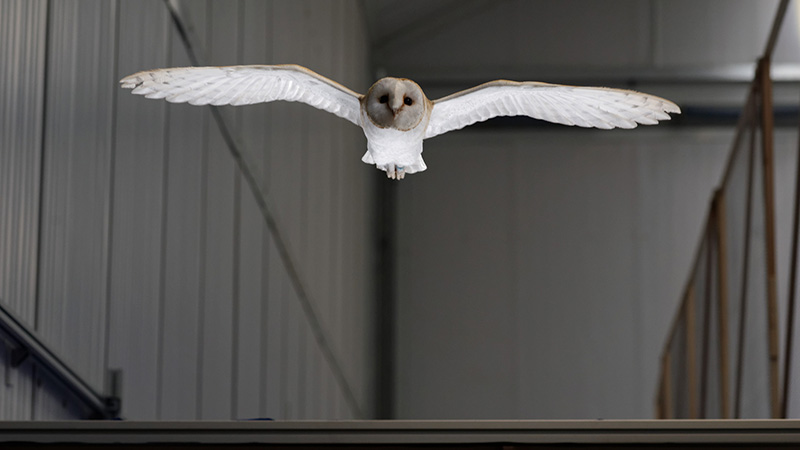Lily the barn owl reveals how birds fly in gusty winds
Scientists from the Royal Veterinary College (RVC) and the University of Bristol have discovered how birds are able to fly in gusty conditions – findings that could inform the development of bio-inspired small-scale aircraft.
The study, published in Proceedings of the Royal Society B, reveals how bird wings act as a suspension system to cope with changing wind conditions. The team used an innovative combination of high-speed, video-based 3D surface reconstruction, computed tomography (CT) scans, and computational fluid dynamics (CFD) to understand how birds ‘reject’ gusts through wing morphing, i.e. by changing the shape and posture of their wings.
Explaining the process, Dr Shane Windsor from the Department of Aerospace Engineering at the University of Bristol, said:
“Birds routinely fly in high winds close to buildings and terrain - often in gusts as fast as their flight speed. So, the ability to cope with strong and sudden changes in wind is essential for their survival and to be able to do things like land safely and capture prey.
“We know birds cope amazingly well in conditions which challenge engineered air vehicles of a similar size but, until now, we didn’t understand the mechanics behind it.”
In the experiment, conducted in the Structure and Motion Laboratory at the RVC, the team filmed Lily, a barn owl, gliding through a range of fan-generated vertical gusts. The strongest of these gusts matched her own flight speed. Lily is a trained falconry bird who is a veteran of many nature documentaries, meaning the lights and cameras did not faze her in the least.

Describing the owl’s reaction to the vertical gusts, Professor Richard Bomphrey, Professor of Comparative Biomechanics at the RVC, said:
“We began with very gentle gusts in case Lily had any difficulties, but soon found that - even at the highest gust speeds we could make - Lily was unperturbed; she flew straight through to get the food reward being held by her trainer, Lloyd Buck.”
Dr Jorn Cheney, lead author of the paper and Postdoctoral Research Associate at the RVC, explained:
“Lily flew through the bumpy gusts and consistently kept her head and torso amazingly stable over the trajectory, as if she was flying with a suspension system. When we analysed it, what surprised us was that the suspension-system effect wasn’t just due to aerodynamics but benefited from the mass in her wings.”
In humans, each of our upper limbs comprises 5 per cent of our total bodyweight. For a bird, however, it is double that; and this extra mass is used to absorb the gust, explaining why Lily was able to remain stable despite the turbulence of the vertical gusts.
Dr Jonathan Stevenson, Research Associate in the Faculty of Engineering at Bristol University, added:
“Perhaps most exciting is the discovery that the very fastest part of the suspension effect is built into the mechanics of the wings, so birds don’t actively need to do anything for it to work. The mechanics are very elegant.
“When you strike a ball at the sweet spot of a bat or racquet, your hand is not jarred because the force there cancels out. Anyone who plays a bat-and-ball sport knows how effortless this feels. A wing has a sweet spot, just like a bat.”
The team’s analysis suggests that the force of the gust acts near this sweet spot and this markedly reduces disturbance to the body during the first fraction of a second. The process is automatic and buys just enough time for other stabilising processes to kick in.
The next step for the research, which was funded by the European Research Council (ERC), Air Force Office of Scientific Research (AFOSR) and The Wellcome Trust, is to develop bio-inspired suspension systems for small-scale aircraft.
Research reference
Cheney Jorn A., Stevenson Jonathan P. J., Durston Nicholas E., Song Jialei, Usherwood James R., Bomphrey Richard J. and Windsor Shane P. 2020. Bird wings act as a suspension system that rejects gusts Proc. R. Soc. B. 287 20201748 DOI: 10.1098/rspb.2020.1748
Notes to Editors
For more information please contact:
- Jasmin De Vivo (Jasmin.DeVivo@plmr.co.uk or rvc@plmr.co.uk
- Press Line: 0800 368 9520
About the RVC
- The Royal Veterinary College (RVC) is the UK's largest and longest established independent veterinary school and is a Member Institution of the University of London. It was the first in the world to hold full accreditation from AVMA, EAEVE, RCVS and AVBC.
- The RVC is the top veterinary school in the UK and Europe, and ranked as the world’s second highest veterinary school in the QS World University Rankings by subject, 2020.
- The RVC offers undergraduate and postgraduate programmes in veterinary medicine, veterinary nursing and biological sciences.
- In 2017, the RVC received a Gold award from the Teaching Excellence Framework (TEF) – the highest rating a university can receive.
- A research led institution with 79% of its research rated as internationally excellent or world class in the Research Excellence Framework 2014.
- The RVC provides animal owners and the veterinary profession with access to expert veterinary care and advice through its teaching hospitals and first opinion practices in London and Hertfordshire.
You may also be interested in:
-
How changing limb posture helped ancient reptiles grow
New collaborative research from the Royal Veterinary College (RVC), along with the Institute of …

